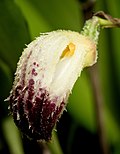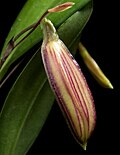| Image | Scientific name | Distribution | Elevation |
|---|
| Zootrophion aguirrei P.Ortiz | Colombia | |
 | Zootrophion alvaroi (Garay) Luer | Colombia to Ecuador. | 400–600 metres (1,300–2,000 ft) |
| Zootrophion antioquianum Uribe Vélez & Sauleda | Colombia (Antioquia) | |
 | Zootrophion argus (Kraenzl.) Luer | Colombia | 1,650–2,500 metres (5,410–8,200 ft) |
 | Zootrophion atropurpureum (Lindl.) Luer | Jamaica, Cuba, Hispaniola, Colombia, Ecuador, and Costa Rica | 400–2,000 metres (1,300–6,600 ft) |
 | Zootrophion beloglottis (Schltr.) Luer | Ecuador and Peru | |
| Zootrophion dayanum (Rchb.f.) Luer | Venezuela, Colombia, Peru and Ecuador | 1,500–1,900 metres (4,900–6,200 ft) |
| Zootrophion disciformis Vierling | South America unknown origin | |
 | Zootrophion dodsonii (Luer) Luer | Colombia and Ecuador | 950–1,000 metres (3,120–3,280 ft) |
| Zootrophion endresianum (Kraenzl.) Luer | Nicaragua, Costa Rica, Colombia and Ecuador | 700–1,500 metres (2,300–4,900 ft) |
| Zootrophion erlangense Roeth & Rysy | Peru | |
| Zootrophion fenestratum (Lindl. ex Hook.) Rysy | Jamaica, Brazil (Rio de Janeiro to Santa Catarina) | |
| Zootrophion fritzwalteri Vierling | South America unknown origin | |
| Zootrophion gracilentum (Rchb.f.) Luer | Nicaragua, Costa Rica and Panama | 700–1,200 metres (2,300–3,900 ft) |
| Zootrophion griffin Luer | Ecuador | 600–1,000 metres (2,000–3,300 ft) |
 | Zootrophion hirtzii Luer | Ecuador | 1,300–2,100 metres (4,300–6,900 ft) |
| Zootrophion hypodiscus (Rchb.f.) Luer | Panama, Colombia and Ecuador | 0–1,800 metres (0–5,906 ft) |
| Zootrophion ildephonsi P.Ortiz | Colombia | |
 | Zootrophion lappaceum Luer & R.Escobar | Colombia(Cundinamarca) | 1,500 metres (4,900 ft) |
| Zootrophion leonii D.E.Benn. & Christenson | Peru (Huancavelica) | 2,300 metres (7,500 ft) |
| Zootrophion machaqway A.Doucette & J.Portilla | Ecuador | |
| Zootrophion muliebre Vierling | South America unknown origin | |
| Zootrophion niveum Luer & Hirtz | Ecuador (Morona-Santiago) | 900 metres (3,000 ft) |
 | Zootrophion oblongifolium (Rolfe) Luer | Ecuador and Peru | 600–950 metres (1,970–3,120 ft) |
| Zootrophion serpentinum Luer | Ecuador | 1,100–1,950 metres (3,610–6,400 ft) |
| Zootrophion trivalve (Luer & R.Escobar) Luer | Colombia | |
| Zootrophion vasquezii Luer | Bolivia | |
| Zootrophion virginalis Vierling | South America unknown origin | |
 | Zootrophion vulturiceps (Luer) Luer | Costa Rica | 1,400–1,700 metres (4,600–5,600 ft) |
| Zootrophion williamsii Luer | South America unknown origin | |
 | Zootrophion ximenae (Luer & Hirtz) ined. | Ecuador | 900–1,500 metres (3,000–4,900 ft) |
|










